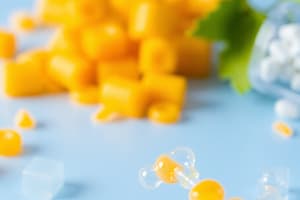Podcast
Questions and Answers
What are the simplest form of carbohydrates called?
What are the simplest form of carbohydrates called?
- Polysaccharides
- Oligosaccharides
- Disaccharides
- Monosaccharides (correct)
D-glucose and L-glucose are known as epimers.
D-glucose and L-glucose are known as epimers.
False (B)
What type of carbohydrate consists of 2-10 monosaccharides linked together?
What type of carbohydrate consists of 2-10 monosaccharides linked together?
Oligosaccharides
The general formula for monosaccharides is Cn(H2O)n, where 'n' represents the number of __________.
The general formula for monosaccharides is Cn(H2O)n, where 'n' represents the number of __________.
Match the following types of carbohydrates with their definitions:
Match the following types of carbohydrates with their definitions:
Which of the following is an example of a polysaccharide?
Which of the following is an example of a polysaccharide?
Alpha-anomers and beta-anomers form due to the cyclization of pentoses and hexoses.
Alpha-anomers and beta-anomers form due to the cyclization of pentoses and hexoses.
What is created during the cyclization of an aldose like glucose?
What is created during the cyclization of an aldose like glucose?
Which of the following statements about the stability of alpha-D-glucose and beta-D-glucose is true?
Which of the following statements about the stability of alpha-D-glucose and beta-D-glucose is true?
Beta-D-glucose has its hydroxyl group in the axial position.
Beta-D-glucose has its hydroxyl group in the axial position.
What is the product of the oxidation of alpha-D-glucose in the presence of silver in Tollen’s Test?
What is the product of the oxidation of alpha-D-glucose in the presence of silver in Tollen’s Test?
The process of converting monosaccharides into deoxy sugars involves substituting a hydrogen atom for one of the ______ groups.
The process of converting monosaccharides into deoxy sugars involves substituting a hydrogen atom for one of the ______ groups.
Match the following oxidation reactions with their corresponding tests:
Match the following oxidation reactions with their corresponding tests:
Which of the following is a common alditol used as a sweetener?
Which of the following is a common alditol used as a sweetener?
Sugar phosphates are a type of sugar ester formed from the reaction of alcohol with phosphoric acid.
Sugar phosphates are a type of sugar ester formed from the reaction of alcohol with phosphoric acid.
What defines a full acetal in carbohydrate chemistry?
What defines a full acetal in carbohydrate chemistry?
Flashcards
Carbohydrate definition
Carbohydrate definition
Organic compounds made of carbon, hydrogen, and oxygen.
Monosaccharide
Monosaccharide
Simplest carbohydrate; a single sugar unit.
Oligosaccharide
Oligosaccharide
Carbohydrate formed by linking a few (2-10) monosaccharides.
Polysaccharide
Polysaccharide
Signup and view all the flashcards
Enantiomers
Enantiomers
Signup and view all the flashcards
Epimers
Epimers
Signup and view all the flashcards
Anomeric Carbon
Anomeric Carbon
Signup and view all the flashcards
α-anomer vs β-anomer
α-anomer vs β-anomer
Signup and view all the flashcards
Mutarotation of Glucose
Mutarotation of Glucose
Signup and view all the flashcards
β-D-Glucose Stability
β-D-Glucose Stability
Signup and view all the flashcards
Tollens' Test
Tollens' Test
Signup and view all the flashcards
Lactone Formation
Lactone Formation
Signup and view all the flashcards
Deoxy Sugar
Deoxy Sugar
Signup and view all the flashcards
Alditol Formation
Alditol Formation
Signup and view all the flashcards
Sugar Esters
Sugar Esters
Signup and view all the flashcards
Glycoside Formation
Glycoside Formation
Signup and view all the flashcards
Study Notes
Carbohydrates
- Carbohydrates are organic compounds composed of carbon, hydrogen, and oxygen.
- They are categorized into monosaccharides, oligosaccharides, and polysaccharides.
Monosaccharides
- Simplest form of carbohydrates, also called simple sugars.
- General formula: Cn(H₂O)n
- Examples: glucose, fructose, galactose
- Building blocks of carbohydrates
- Cannot be broken down further by hydrolysis.
Oligosaccharides
- Formed by linking a few (2-10) monosaccharides.
- Examples: disaccharides like sucrose (table sugar) and lactose (milk sugar).
Polysaccharides
- Large molecules composed of many monosaccharide units.
- Examples: starch, cellulose, glycogen.
Stereoisomers
- Enantiomers: Mirror-image stereoisomers
- D-glucose and L-glucose are enantiomers.
- Epimers: Sugars that differ in configuration at only one chiral center.
- D-glucose and D-mannose are C-2 epimers.
- D-glucose and D-galactose are C-4 epimers.
Cyclization and Anomers
- Monosaccharides with 5 or 6 carbon atoms often form ring structures.
- Cyclization occurs when a carbonyl group reacts with a hydroxyl group on the same molecule.
- This creates a new chiral center (anomeric carbon).
- The resulting ring structure exists in two forms: α-anomer and β-anomer.
- Hemiacetals and hemiketals are more stable than their corresponding open-chain forms.
Haworth Projections
- Two-dimensional representations of the cyclic forms of monosaccharides.
Mutarotation
- Interconversion of α and β anomers.
Chair Conformation of Glucose
- β-D-glucose is more stable than α-D-glucose.
- The equatorial position of the hydroxyl group on C1 in β-forms is more stable than the axial position in α.
Oxidation Reactions
- Oxidation reactions convert aldoses to lactones.
- Tollens' test example of an oxidation reaction.
- A cyclic ester linking the carboxyl group and a sugar alcohol is called a lactone.
Reduction Reactions
- Reduction reactions convert sugars to deoxy sugars or alditols.
- Deoxy sugars: a hydrogen atom replaces a hydroxyl group, examples include L-fucose and D-2-deoxyribose.
- Alditols: carbonyl group reduced to a hydroxyl group, examples include xylitol and sorbitol.
Sugar Esters, Phosphates, and Glycosides
- Sugar esters result from reacting alcohol with an acid.
- Sugar phosphates are sugar esters.
- Glycosides are formed when hemiacetals or hemiketals react with another alcohol
- Full acetals/ketals: complete replacement of both -OH groups with -OR groups.
Studying That Suits You
Use AI to generate personalized quizzes and flashcards to suit your learning preferences.




